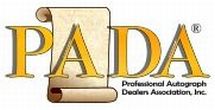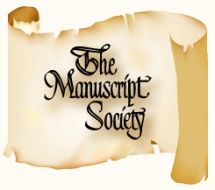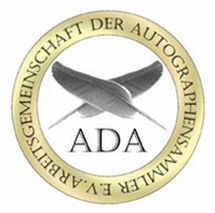1033401
Adolf Hitler
Click on image for larger size
" . . . your old friend and comrade in arms"
Adolf Hitler (1889-1945), Führer and Reich Chancellor of Nazi Germany, 1933-1945. Rare Autograph Note Signed, Adolf Hitler, one page, 4¾" x 7½", Berlin, Germany, December 24, 1936.
Hitler's holograph material, particularly after he became Chancellor in 1933, is rare, and this is an excellent association piece in addition. Hitler, as Führer and Reich Chancellor, sends warm Christmas greetings to a friend, describing himself as "your old friend and comrade in arms." The partially printed greeting, thus annotated, reads, in full: “Your old friend and comrade in arms sends you cordial good wishes of the Christmas season."
To our knowledge, this piece has not been on the market before. We acquired it from the family of an American soldier who brought it back home after World War II. The soldier and some of his command sought shelter in the ruins of a library in Garching an der Alz, a Bavarian town northeast of Munich. In a bricked-up cubbyhole cracked open from bombing were a few items of silver and several packets of documents belonging to Ernst Schmitt. This Christmas greeting and the accompanying envelope containing it were among the documents.
Like Hitler, Ernst Schmitt (1896-1972) both served in World War I and was an early supporter of the Deutsche Arbeiterpartei, or DAP. Hitler joined the party on September 12, 1919, as its 55th member. To broaden its appeal, the party later changed its name to the Nationalsozialistische Deutsche Arbeiterpartei, or NSDAP—the Nazi Party. Schmitt joined the party as member 5,864 in the watershed year of 1923, the year of the failed Munich Beer Hall Putsch that sent Hitler to prison and resulted in the book that became Mein Kampf. Politically, as the Nazis gradually gained control, Schmitt held local and state governmental positions from 1927 to 1933 and then sat as a delegate for Constituency 21 (Koblenz-Trier) in the German Reichstag from November 1933 until the end of Nazi rule in 1945.
Hence Hitler's outstanding, warm reference here to being an "old friend and comrade in arms" meant both his service in the German Army during World War I and his subsequent political and paramilitary struggles as the leader of the Nazi Party. Hitler served as a Bavarian regimental runner in France and Belgium during World War I, was present during a number of the major battles on the Western Front, and was decorated twice for bravery. He found the war to be "the greatest of all experiences." But he reviled the French acceptance of German surrender aboard a railroad dining car in Compiègne Forest, and like the Germans—Hitler was Austrian—he viewed the Treaty of Versailles, which essentially demilitarized Germany, as humiliation. Indeed, the treaty was such a demoralizing social and political factor that the Nazis' pledge to rearm Germany attracted public support for the National Socialist agenda. Later, as Hitler's Germany in turn accepted the French surrender aboard the same railroad car in the same spot in Compiègne Forest on June 21, 1940—a ceremony that Hitler himself attended at the outset—Hitler's valet noted that he "who had enjoyed the hour of satisfaction had set out the procedure in detail himself. He wanted to bring home to the French by his haughty demeanour the humiliation which in his view they had made him and the German people suffer in 1918." Heinz Linge, With Hitler to the End 142 (2009).
Hitler's handwriting and signature on this piece are in extremely bold, jet black ink. The piece has a bit of soiling and toning and a diagonal crease across the upper left quadrant that touches the printed portion of the message but affects neither Hitler's handwriting nor his gold-embossed crest. Overall it is in fine condition. The envelope is likewise fine.
For the sake of accuracy, we note that the envelope, which is addressed to Schmitt at the railroad terminal restoration at Garching an der Alz, does not appear to be the one in which Hitler's Christmas greeting was originally mailed. The greeting is dated December 24, 1936, but the postmark shows that the envelope was mailed from Munich more than a year later, on December 30, 1937.
We reject Nazism and all that it represented. We nevertheless offered this piece because of its rarity and because of the undeniable role that the Third Reich played in the 20th Century.
Unframed.
_____________
This item has been sold, but
click here to see other
World History items
that we are offering.
|





